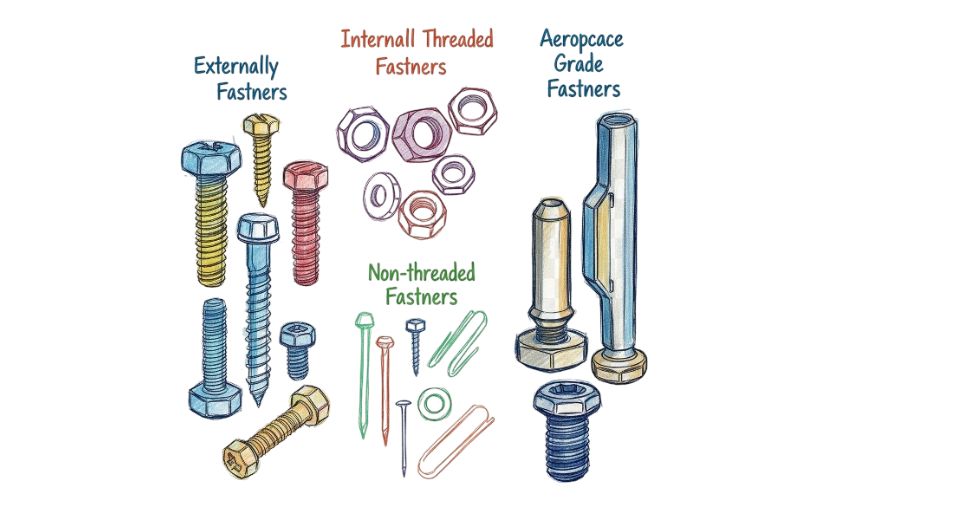
Nov 05, 2025

The latest report by Metastat Insight on the global industrial fasteners market is now, more than ever, important in the context of the industrial landscape. The market is concerned with the fastening of critical equipment that needs to be anchored, aligned and safe - that is when this market comes in. The increasing importance of infrastructure upgrades, mobility change and manufacturing modernization has brought fastening solutions to the forefront as enablers of durable, scalable assemblies.
Market Context
The manufacturing, construction and transportation industries are under a lot of pressure: components must be stronger but at the same time lighter, global supply chains expect very short lead times and regulations require full traceability and quality assurance. High-quality fastening hardware is, therefore, spending its life times in the specialist engineering hardware. The industrial fasteners market is perfectly positioned to meet the demands of the future. It does so by providing the hardware that connects frames, modules and systems with reliability. The demand for fastening solutions that can endure high loads, vibrational and varied environmental conditions is becoming a necessity with the growth of industries like automotive, aerospace and infrastructure.
How It Works / Why It’s Valuable
The fastening hardware, which includes bolts, screws, nuts, rivets, washers, and others, has the main function of ensuring mechanical fixation that is, securely joining components to allow devices, structures, or vehicles to function the way they were intended. The value is coming from the strong raw-materials (like alloy steels, stainless steel, and engineered plastics) along with the coatings and surface treatments that can resist corrosion, fatigue and thermal stress. When assembly operations demand high precision or repetition, specially designed fasteners offer remarkable benefits: reduced upkeep, longer life, automation compatibility, and better quality documentation. Their use ranges from mounting heavy machinery frames, and securing structural steel to joining vehicle chassis systems, and connecting aerospace modules each use case making the need for reliable fastener solutions very clear.
Growth Story / Technological Evolution
The industrial fasteners market has gradually moved from commodity hardware to sophisticated offerings. The early supply models were all about the bulk supply of standard bolts and nuts; now the focus is on value-added fasteners that come with special coatings, traceability, custom finishes, and integration with assembly automation. Some examples of these innovations are lightweight composite fasteners, fasteners that are treated for extreme environments, and smart fastening solutions that have sensors or identifiers embedded in them. Global standards in aerospace or energy have raised the qualification thresholds, thus fasteners are often carrying certifications and testing regimes that were earlier reserved for major sub-systems. These developments have helped to change the view of fastening hardware ecosystem from a mere procurement item to a strategic engineering component.
Regional or Global Trends
The Asia-Pacific area is at the forefront of fastening solutions’ adoption, which is majorly driven by industrialization, infrastructure development and automotive manufacturing. Market studies reveal that Asia-Pacific was the largest revenue contributor to the industrial fasteners sector. North America, on the other hand, is taking advantage of the transition to renewable energy, electric vehicle production and relocation of industrial activities which are resulting in a demand for quality and traceable fastening solutions. Countries like India are already highlighted as the most promising ones in terms of growth, as the local factories and sourcing by global companies are both getting larger. Meanwhile, the ongoing infrastructure projects in Africa and Latin America can be seen as a good opportunity for the growth of fastening hardware, especially with the rise of modular construction and large-scale industrial machinery installations.
Challenges and Opportunities
The sudden changes in cost are still one of the major challenges; the variations in the prices of raw materials (mainly steel and alloy steels) directly affect the profit margins and the purchasing strategies. Quality assurance and imitation pose problems the fasteners applied to safety-critical areas have to meet the set limits and provide the required paperwork, while overstressed or inferior quality hardware might cause malfunction. In addition, in some cases; such as adhesives, welding or bonding, the demand for traditional fasteners is limited due to the availability of their substitutes. Conversely, the market has been opened for more existing and new products: as machines and vehicles become lighter, more complex or electrified, fasteners must also keep pace bringing forth high-strength, corrosion-resistant and smart components. Further, collaboration with automation (robot-driven assembly) and digital supply-chains (traceability, part-management) will not only enhance the existing but also open completely new channels of value. Furthermore, the geographical expansion into less saturated markets will provide more options for growth.
Why It Matters Now
In a world confronting sustainability imperatives, digital transformation and global infrastructure demands, the industrial fasteners market presented by Metastat Insight occupies a subtle yet significant role. Fasteners supply the mechanical backbone of structures, vehicles and machines and as industries push toward cleaner mobility, smarter manufacturing and resilient infrastructure, reliable joining solutions matter. The future will favour fastening technologies that can adapt across materials (for lighter vehicles), support data-enabled assembly (for traceability) and deliver durability in extreme environments (for renewable energy or advanced infrastructure). In short, this market is integral to shaping how things get built, connected and maintained in the decades ahead.
Drop us an email at:
Call us on:
+1 214 613 5758
+91 73850 57479